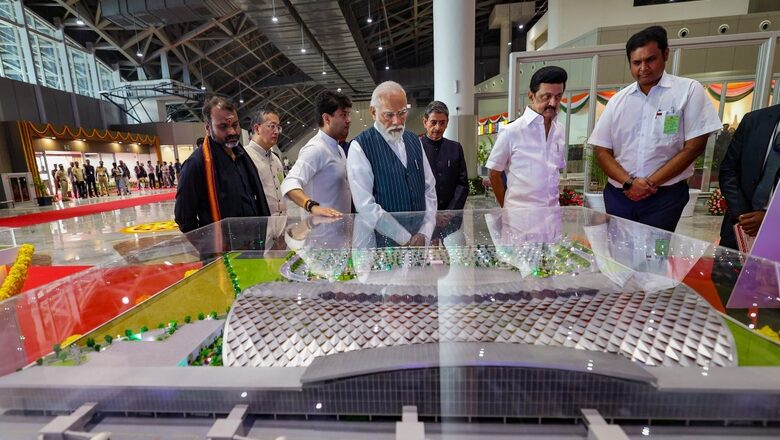
views
A yearly report from the Directorate General of Civil Aviation (DGCA) shows a 40 per cent increase in the licenses issued in 2023 in comparison to 2022. The Indian aviation industry is taking flight, and as the data suggests, so are Indians. In its annual report, DGCA revealed that a record 1,632 Commercial Pilot Licenses (CPL) were issued last year.
Most heartening is the increasing diversity unfolding. Female representation amongst pilots has tripled over the past decade to 18 per cent of the latest cohort, highlighting progressive societal changes. For a nation accounting for one of the world’s highest percentages of female aviators even today, mainstreaming their greater participation further bodes exceptionally well. But that’s not all.
To cater to the growing demand in civil aviation, domestic players such as Indigo and the now privatised Air India have ordered a record 1000 airplanes. A never-seen-before record in civil aviation history.
The Indian aviation sector is the third-largest domestic market globally, surpassed only by the United States and China. The Mumbai to Delhi route is now the world’s third busiest, and according to India’s Centre for Asia Pacific Aviation (CAPA), the industry served approximately 200 million passengers in the financial year ending March 2023. Presently, there are 140 functional airports in India, and the government aims to add another 200 in the next five years.
At the core of this unprecedented growth is India’s burgeoning aspirational middle class with rising incomes, deregulatory reforms unleashing entrepreneurial energies, and visionary policy actions aimed at inclusive development through universal air connectivity. The cumulative impact of these synergistic forces over the last decade has been nothing short of revolutionary.
Dawn of a New Era
Domestic flights in India began over eight decades ago but faced slow growth due to socialist controls and Air India’s monopoly. The industry saw a significant shift from 2013-14 onwards with reforms, including the removal of price caps, leading to competitive dynamics and more affordable flying options.
Relaxations in ownership rules allowed low-cost carriers like IndiGo, SpiceJet, and GoAir to revolutionise the sector. These changes, along with the liberalisation of international operations and initiatives like the UDAN regional connectivity scheme, propelled India’s civil aviation to become one of the fastest-growing sectors. Passenger traffic grew from 60 million in 2010 to an estimated 400 million by 2027.
To meet the growing demand, the Modi government is actively promoting flying training organisations (FTOs) to enable cadet pilots to undergo training within the country rather than going abroad for expensive programs. India is projected to need an additional 34,000 pilots and 45,000 aircraft technicians by 2040. In response, the government awarded nine initial contracts in 2021 to establish new FTOs at airports in Belagavi (Karnataka), Jalgaon (Maharashtra), Kalaburagi (Karnataka), Khajuraho (Madhya Pradesh), and Lilabari (Assam). As of now, six of these are operational. In the following year, six more contracts were awarded, with one currently operational. According to the Ministry of Civil Aviation in India, there are presently 36 FTOs operating at 57 bases across the country.
Despite the opening of several new FTOs, challenges persist in India’s flying training sector. Issues include the comparatively longer time required to accumulate the necessary flying hours for a Commercial Pilot License (CPL) compared to faster options abroad, albeit at a higher cost. Safety concerns and a perceived lack of desired training quality in certain locations are also challenges.
A Gigantic Scaleup
Indian carriers are making unprecedented commitments to aircraft purchases to meet the growing domestic and international demand. Air India’s historic $70 billion deal for 470 Airbus and Boeing planes, along with IndiGo’s plan to add 500 aircraft to its fleet, stands out globally.
To support such substantial fleet expansions, infrastructure enhancements are crucial. Major airports are investing in additional runways and expanding terminals, aiming to quadruple capacities by 2030 to handle over 100 flight movements per hour. Advanced air navigation technologies, facilitating all-weather CAT III low visibility operations, are being progressively implemented.
Across the country, thousands of acres are being allocated for integrated Maintenance, Repair, and Overhaul (MRO) clusters. These clusters aim to service over 500 planes locally by 2040. Greenfield projects like Jewar and Navi Mumbai international airports are underway to alleviate congestion in Delhi and Mumbai, boosting industrial development in their surrounding areas.
In 2023, the Indian government announced a commitment to spend Rs 980 billion ($11.88 billion) by 2025 to enhance regional connectivity through the construction of new airports and the modernisation of existing ones. The focus is on developing cutting-edge and sustainable airport infrastructure to accompany the expansion of the aviation sector.
The expansion has also led to the expansion of airports throughout the country. The Indira Gandhi Airport in New Delhi is expanding rapidly, having added a fourth runway and an elevated taxiway in July. GMR Airports took over in 2006 when arrivals had to navigate past lazing cows to reach a taxi stand. By 2018, the airport was rated as India’s most valuable infrastructural asset. To reduce jet fuel usage, a battery-powered TaxiBot now tows idling planes, and an automated luggage-handling system efficiently sorts 6,000 bags per hour.
The airport infrastructure expansion is not limited to major metropolitan areas. Under the leadership of Prime Minister Narendra Modi, the number of airports in India has doubled from 74 to 148 in nine years, with plans to reach at least 230 by 2030. The government has invested over $11 billion in airports in the past decade, with an additional promise of $15 billion from Aviation Minister Jyotiraditya Scindia.
This extensive investment means that even smaller towns like Darbhanga in Bihar now have nonstop access to major cities like Delhi and Bengaluru. The increased connectivity has transformed travel for the 900 daily passengers, including many from nearby Nepal. Furthermore, Tamil Nadu’s newly built terminal at Tiruchirappalli International Airport, developed at a cost of Rs 1100 crore, is set to serve thousands of passengers. It was inaugurated by Prime Minister Narendra Modi on January 2, 2024.
Economic Impact
IATA estimates indicate that aviation contributes directly to India’s GDP, contributing Rs 1.6 trillion annually. With the return of traffic to pre-pandemic levels and the complete reopening of international borders, projections suggest this figure will surpass Rs 2 trillion by 2024 and reach Rs 5 trillion by 2030. This growth is expected to create 10 million new jobs, both directly in aviation and indirectly by enhancing connectivity, particularly in sectors like tourism.
According to a PwC report, introducing every 100 new routes in India generates 70,000 jobs and adds $1.7 billion to economic activity annually. With UDAN introducing over 450 routes to date, the cumulative impact translates to millions of jobs and an annual GDP increase exceeding $10 billion, an achievement unparalleled by any global infrastructure program. This widespread access is fostering inclusive development by linking previously considered inaccessible remote areas.
The Year 2024: Another Step
2023 served as a breakthrough year for the Indian aviation industry. Domestic players such as Air India and IndiGo set the global aviation industry on alert by placing the biggest orders in civil aviation history.
This year, the orders will start coming through, with Air India highlighting that it’ll take delivery of one new plane every six days throughout 2024. More so, domestic infrastructure will also undergo transformation. Moneycontrol reports around 15 new airports, including the Noida International Airport in Jewar and the DB Patil International Airport in Navi Mumbai, are expected to be inaugurated in 2024. The government is also working to come up with a new national policy to transform Indian airports into major international hubs that will offer single-point international connectivity to the South Asian region.
2024 will also see the fifth round of the UDAN flight auction. It would see the auction of 50 new routes for small and big airlines. Another auction will be held for the privatisation of airports with seven clusters to be privatised. All of it is to fulfill the government’s vision of Indian aviation in the year 2040, which has been meticulously detailed in the report titled “Vision 2040.”
Vision 2040
In 2019, the Indian Ministry of Civil Aviation released a report titled Vision 2040, projecting a six-fold surge in air passenger traffic in the subcontinent to reach 1.1 billion by 2040. The forecast includes 821 million domestic and 202 million international passengers. According to Vision 2040, the escalating demand for passenger transport will necessitate a fleet of 2359 aircraft to efficiently manage all air traffic by March 2040.
Vision 2040 for the nation’s aviation sector emerges as a meticulously planned roadmap, aiming to transform the industry into a global powerhouse. Some key components are:
Infrastructure Development
- Vision 2040 targets the construction of over 100 new airports across the country, expanding the current count from 137 to more than 200.
- An investment of over $50 billion is earmarked for airport modernisation and technology integration, ensuring world-class facilities and operational efficiency.
Affordability and Accessibility
- The government aims to reduce the cost of air travel significantly. Ticket prices are projected to decrease by an average of 30 per cent, making air travel more accessible to a larger demographic.
- Investments in technological advancements, including air traffic management systems, are expected to save operational costs, contributing to the affordability goal.
Sustainability Initiatives
- A substantial budget of $15 billion is allocated for research and development in green aviation technologies, with a target to have at least 30 per cent of the aviation fleet running on eco-friendly alternatives by 2040.
- Carbon emissions reduction goals include a 50 per cent decrease in the emissions per passenger kilometre, aligning with international efforts to combat climate change.
International Collaboration
- Collaboration agreements have been established with leading global aviation players. These partnerships aim to share best practices, foster innovation, and facilitate knowledge transfer.
- An estimated 20 per cent increase in international air traffic is expected, creating new opportunities for economic growth through enhanced connectivity.
Job Creation and Economic Impact
- The aviation sector’s expansion is anticipated to generate over 3 million direct jobs and 6 million indirect jobs, contributing significantly to employment and economic growth.
- The projected GDP contribution of the aviation sector is expected to increase from the current 7 per cent to around 12 per cent, indicating a substantial boost to the national economy.
Global Recognition
India’s aviation prowess has not gone unnoticed globally. The world watches as the country, with the third-largest domestic market and a record-breaking aircraft order, emerges as a key player. This recognition brings not only economic dividends but also reinforces India’s standing on the global stage.
Companies like Boeing have taken note of India’s growth in the airline industry. According to Boeing’s study, the demand for new aircraft in the next two decades is estimated to be 2,200, valued at around $320 billion. Airbus has also projected an annual growth rate of over 11 per cent for the domestic market in the next 10 years, with the combined rate for domestic and international routes exceeding 10 per cent.
During the Paris Air Show last year, Indian carriers IndiGo and Air India made record-breaking aircraft orders, surpassing 1,000 aircraft. This garnered global attention, and international leaders, including British Prime Minister Rishi Sunak, acknowledged the significance of these deals. The endorsement from the global community highlights India’s growing role as a major player in the aviation market, positively impacting not only its own aerospace sector and job market but also influencing the global dynamics of the industry.
The Widespread Benefits
Expanding on the success of Phase I, the Ministry is actively enhancing efforts in Phase II of UDAN to increase connectivity. Plans include adding over 200 new routes by 2026, and strategically connecting smaller towns in identified backward regions and economic clusters. Priority areas include the Northeast with its mineral-rich resources, the culturally significant Central Indian temple circuit, and the coastal Karnataka region with ambitious sea plane introduction projects. To ensure seamless connections to and from these emerging aviation hubs, complementary investments in surface transportation are being made.
Key airports in states like Madhya Pradesh, West Bengal, and Rajasthan are being rapidly developed through hybrid public-private models. Mega projects such as the upcoming Noida International Airport near Delhi and Sindhudurg in coastal Maharashtra aim to stimulate balanced regional growth.
The Regional Connectivity Scheme (UDAN) has an allocation of Rs 1,244.07 crore ($14.98 million) for 2023-24, aiming to enhance air connections in the domestic market. This scheme benefits not only tourists but also focuses on the development of 100 airports, helipads, and water aerodromes by 2024 through the Revival of Unserved and Underserved Airports program. These facilities play a crucial role in transporting perishable food items from remote areas, supporting farmers, and serving various purposes like humanitarian efforts, crop spraying, and forest fire suppression. The scheme has identified 58 airports to stimulate the air cargo market, promoting overall connectivity and accessibility.
Recognising the crucial role of air connectivity, state governments are investing in aviation infrastructure. Institutions like the Kerala Aviation Academy, benchmarked internationally, are fostering skilled personnel, contributing to structural transformation in remote areas of India. This collaborative federal approach holds promising prospects for fostering inclusive prosperity through aviation-driven opportunities in the long run.
UpSkilling India’s Aviation Workforce
Developing the workforce for India’s aviation sector, expected to employ over 4 million people directly and indirectly by 2047, is crucial. Various initiatives are in progress, including the establishment of specialised aviation academies and flying clubs by leading states, all of which comply with international standards.
Boeing has also announced it will invest $100 million into infrastructure and pilot training programs within the country over the next two decades. Once implemented, this holistic system will generate a skilled workforce, enriching lives and livelihoods across India. To ensure public trust in the face of expanding operations, regulations are continuously strengthened.
In the long term, introducing aviation and aerospace modules in school curricula, particularly for girls, can gradually make aviation a natural career choice. Similarly, there’s untapped potential in harnessing skills from tribal and rural communities. According to the 2011 Census, India’s Adivasi population exceeds 100 million, concentrated in central and eastern regions, with many residing near upcoming aviation clusters under UDAN Phase 2.
Safety, Regulation and Oversight
The Indian Civil Aviation Ministry is dedicated to cultivating top-notch regulators to foster a strong safety-first culture, especially with the territorial expansion of aircraft. This commitment is crucial for realising the full economic potential of aviation sustainably and maintaining public trust.
As Indian aviation experiences exponential growth in scale and complexity, ensuring the highest safety standards poses a significant challenge for regulators. A key focus is substantial investment in research and development, leveraging advancements in biometrics, AI, and 5G communications to enhance oversight capabilities.
Establishing an independent ‘Air Safety Investigation Bureau’, aligned with international best practices observed by NTSB and BEA, can provide invaluable insights into incidents. These findings should systematically influence policy to promote a proactive safety-first culture. Identifying risks at the design and certification stages through collaborative oversight models is vital. Regulators stand to benefit greatly from engagements with global investigation agencies and industry bodies like IATA to stay updated on the evolving risk landscape.
Enhancing field offices with mobile virtual reality simulators can improve surveillance of remotely located airports and airstrips. Real-time situational awareness gains will complement traditional audits conducted in print and online. Additionally, the development of digital twins for both aircraft and airspace holds immense potential in ensuring comprehensive oversight.
Flying towards a brighter future
Aviation experienced a steady 15 per cent annual growth in the decade before the pandemic, and India’s boom is poised to reshape the global aviation landscape. If the gains enjoyed by the successful players in India’s economy can be encouraged to spread to other sectors, a similar positive impact may be possible elsewhere.
India’s civil aviation boom is not just a numerical surge in CPLs, it signifies a paradigm shift in the country’s aspirations. The DGCA’s adaptability, regulatory changes, and the government’s strategic investments lay the foundation for a soaring India.
As the industry propels itself into the future, the focus on infrastructure, skilled workforce development, and vigilant oversight ensures that the soaring ambitions of India’s aviation sector are not only met but surpassed. The stage is set for a brighter and more connected future in the skies.
Views expressed in the above piece are personal and solely that of the author. They do not necessarily reflect News18’s views.




















Comments
0 comment